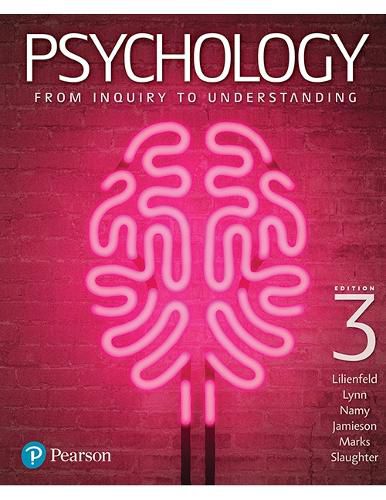Readings Newsletter
Become a Readings Member to make your shopping experience even easier.
Sign in or sign up for free!
You’re not far away from qualifying for FREE standard shipping within Australia
You’ve qualified for FREE standard shipping within Australia
The cart is loading…






The goal of this text is to empower students to apply scientific thinking to the psychology of their everyday lives. By applying scientific thinking - thinking that helps protect us against our tendencies to make mistakes - we can better evaluate claims about both laboratory research and daily life. Students will emerge with the critical-thinking skills and open-minded scepticism they need to distinguish psychological misinformation from psychological information. The product is designed to encourage students to keep an open mind to new claims, but to insist on and evaluate evidence informing these claims.
Samples Download the detailed table of contents
Preview sample pages from Psychology: From Inquiry to Understanding
Features
Students are supported in preparing for industry, with content aligned to professional standards.
The content is heavily localised and revised to include more Australian examples to reflect practice in an Australian context.
Content is localised and has been revised to include more Australian examples.
Includes qualitative research, epigenetics and positive psychology.
Updated citations, examples and statistics.
New to this edition
Mapped to APAC Graduate Competencies - The newly updated APAC Graduate Competencies are linked throughout the text.
Significant update to Chapter 14 Cross-cultural psychology delves into how culture affects people in different cultural and social settings. It includes new coverage of cross-cultural differences in basic processes of cognition, expression of anger and its effect on health, socialisation and helping behaviours. The chapter also includes extended coverage of research on acculturation and multicultural identity.
Structure and internal design - The language has been simplified so that readability is enhanced. Images, figures, statistics, citations and examples have been updated and improved, strengthening ways for students to learn. New chapter-based pedagogical features including
Colour-coded biological art ‘Challenge your assumptions’ questions Fully revised ‘Evaluating claims’ scenarios ‘Fact or fiction?’ questions ‘Stop and think’ questions
These new features provide students opportunities to develop their soft-skills within the study of psychology (critical-thinking, problem-solving, self-reflection, analysis, etc). Colour-coded feature orients students at both the macro and micro levels as they move through the text. Through ‘Challenge your assumptions’, students are asked what they believe they know about psychology and are then prompted to use scientific-thinking skills to evaluate claims they are likely to encounter in various forms of media (‘Evaluating claims’). ‘Fact or Fiction’ questions are peppered throughout each chapter, challenging students’ ability to distinguish supported from unsupported claims. This is then summarised in ‘Stop and think’, where students write short critical-thinking-based responses to questions about the chapter content.
$9.00 standard shipping within Australia
FREE standard shipping within Australia for orders over $100.00
Express & International shipping calculated at checkout
The goal of this text is to empower students to apply scientific thinking to the psychology of their everyday lives. By applying scientific thinking - thinking that helps protect us against our tendencies to make mistakes - we can better evaluate claims about both laboratory research and daily life. Students will emerge with the critical-thinking skills and open-minded scepticism they need to distinguish psychological misinformation from psychological information. The product is designed to encourage students to keep an open mind to new claims, but to insist on and evaluate evidence informing these claims.
Samples Download the detailed table of contents
Preview sample pages from Psychology: From Inquiry to Understanding
Features
Students are supported in preparing for industry, with content aligned to professional standards.
The content is heavily localised and revised to include more Australian examples to reflect practice in an Australian context.
Content is localised and has been revised to include more Australian examples.
Includes qualitative research, epigenetics and positive psychology.
Updated citations, examples and statistics.
New to this edition
Mapped to APAC Graduate Competencies - The newly updated APAC Graduate Competencies are linked throughout the text.
Significant update to Chapter 14 Cross-cultural psychology delves into how culture affects people in different cultural and social settings. It includes new coverage of cross-cultural differences in basic processes of cognition, expression of anger and its effect on health, socialisation and helping behaviours. The chapter also includes extended coverage of research on acculturation and multicultural identity.
Structure and internal design - The language has been simplified so that readability is enhanced. Images, figures, statistics, citations and examples have been updated and improved, strengthening ways for students to learn. New chapter-based pedagogical features including
Colour-coded biological art ‘Challenge your assumptions’ questions Fully revised ‘Evaluating claims’ scenarios ‘Fact or fiction?’ questions ‘Stop and think’ questions
These new features provide students opportunities to develop their soft-skills within the study of psychology (critical-thinking, problem-solving, self-reflection, analysis, etc). Colour-coded feature orients students at both the macro and micro levels as they move through the text. Through ‘Challenge your assumptions’, students are asked what they believe they know about psychology and are then prompted to use scientific-thinking skills to evaluate claims they are likely to encounter in various forms of media (‘Evaluating claims’). ‘Fact or Fiction’ questions are peppered throughout each chapter, challenging students’ ability to distinguish supported from unsupported claims. This is then summarised in ‘Stop and think’, where students write short critical-thinking-based responses to questions about the chapter content.